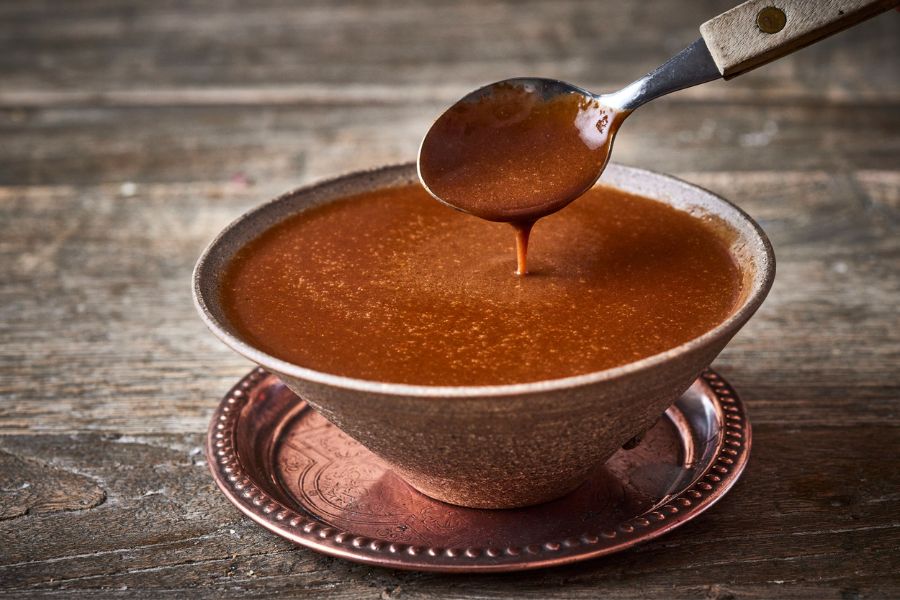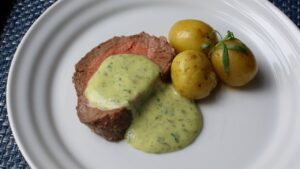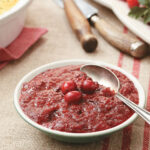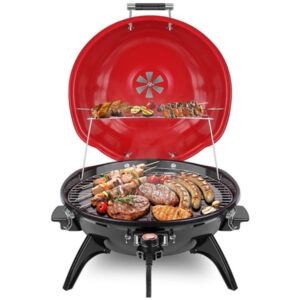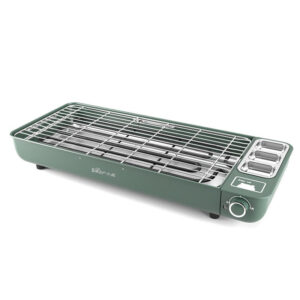In Nordic tradition, Brown sauce is a commonly used brown sauce widely employed in Norway and Sweden. It’s well known that this sauce pairs exceptionally well with meatballs. In the past in the Nordic region, certain seasonings were relatively scarce, so Nordic cuisine didn’t rely heavily on spices and herbs for flavoring like French or Italian cuisines. Instead, Nordic cuisine tended to use simple ingredients to create rich and hearty home-cooked dishes, and sauces of this kind also provided warmth during the cold climate.
I’m sure Brown sauce is familiar to you, but have you ever considered using this sauce for BBQ grilling? It turns out, this is entirely feasible! And, with some minor adjustments, we can make Brown sauce more suitable for barbecuing.
In the following article, I will detail the steps to create the traditional Brown sauce and share how to modify it to make a delicious sauce specifically for BBQ grilling. Additionally, I will provide pairing and usage suggestions for this sauce, as well as preservation tips. Let’s explore how to integrate this tasty sauce into your barbecue experience!
Traditional Norwegian Brown Sauce Recipe
Ingredients
- 4 tablespoons butter
- 4 tablespoons flour
- 1 liter milk
- 60ml caramelized sugar syrup/molasses
- 1/4 teaspoon ground cinnamon
- Salt and black pepper to taste
Instructions
1, Put a pot over medium-low heat, add butter, and allow it to melt. Be cautious not to overheat or boil the butter to prevent burning.
2, Gradually add the flour while stirring continuously to create a smooth paste. Ensure the flour is evenly sprinkled over the butter and avoid forming lumps while stirring.
3, Continue heating over medium-low heat while stirring constantly for about 2-3 minutes to cook off the raw flour taste. Avoid letting the mixture become overly yellow or toasted.
4, Slowly pour in the milk, adding it bit by bit while constantly stirring to prevent lump formation. Ensure each addition of milk is well incorporated to prevent lumping and maintain a smooth texture.
5, Add the caramelized sugar syrup, ground cinnamon, a suitable amount of salt, and black pepper according to your taste. Mix well to evenly distribute the seasonings. Gradually add the seasonings to adjust the taste to your preference.
6, Bring the sauce to a boil, then reduce the heat and continue to simmer for about 5-10 minutes until the sauce thickens. Once the desired consistency is achieved, remove from heat. Avoid letting the sauce boil excessively to prevent scorching or spilling over.
The combination of butter, flour, and milk is the foundation of the classic French white sauce béchamel. This wonderful sauce exudes a rich dairy aroma, with a gentle flavor that doesn’t overpower the taste of other foods, making it an excellent companion for vegetables and pasta. Moreover, it serves as an ideal base for many other sauces, allowing for the addition of more herbs and seasonings to create delicious variations.
For a richer meaty flavor in Brown sauce, a simple modification can enhance the experience. You can replace 1 liter of milk with 500ml milk and 500ml meat broth, or even 250ml milk and 750ml meat broth. This adjustment depends on your taste, imparting a more robust flavor.
The color of Brown sauce comes from the caramelized sugar syrup used. This syrup is made by heating sugar and water until it turns brown. While you can make this caramel at home as it requires simple ingredients, it’s quite precise in terms of timing – if not careful, the sugar can easily become overly caramelized, and adding water won’t restore it. It’s recommended to purchase this syrup from a supermarket. Caramelized sugar syrup is usually dark brown to black, contributing to the distinct deep brown color of the sauce, along with a subtle sweetness and slight bitterness.
Cinnamon is characterized by its warm, aromatic, and slightly sweet profile. Adding it to Brown sauce imparts a pleasant aroma and a hint of subtle spiciness. However, cinnamon is a potent spice, so its quantity should be carefully managed. If too much is used, it might overpower the sauce’s balance.
Lastly, season with a suitable amount of salt and pepper to create a rich and rounded flavor.
The above instructions outline the process for making traditional Brown sauce. Next, we’ll explore how to make it even more suitable for barbecue grilling.
Crafted for BBQ Delight: Enhanced Brown sauce Recipe
Unlike the traditional Brown sauce, sauces used for BBQ are often tomato-based with elements like peppers and vinegar, offering smoky, sweet, and spicy profiles.
Ingredients for BBQ-enhanced Brown sauce Recipe
- 500ml broth (chicken or beef)
- 250ml tomato sauce
- 60ml traditional Norwegian Brown sauce (as mentioned in the previous recipe)
- 60ml apple cider vinegar
- 2 tablespoons dark syrup
- 1 tablespoon soy sauce
- 1 teaspoon smoked paprika/garlic powder/onion powder
- Salt and black pepper, to taste
Instructions
1, Combine the meat broth, tomato sauce, traditional Norwegian Brown sauce, apple cider vinegar, and dark syrup in a pot over medium heat.
This step forms the base liquid of the sauce. By initially blending these ingredients while heating, they gradually meld with others as the temperature rises. During the heating time, they create a harmonious and refined flavor profile.
2, Once mixed, add the soy sauce, smoked paprika, salt, and black pepper. Continue stirring to thoroughly combine all seasonings.
Both soy sauce and smoked paprika are robust in flavor, so be cautious with their quantities to avoid excessive saltiness or overshadowing other flavors. Not adding soy sauce and smoked paprika in the initial step prevents their intense flavors from overpowering the sauce prematurely.
You can choose smoked garlic powder, smoked sweet paprika, or smoked onion powder for the smoked paprika. Generally, smoked garlic powder is stronger in flavor compared to smoked sweet paprika, while the aroma of smoked sweet paprika is stronger than that of onion powder. I’m an enthusiast of intense flavors, so I tend to choose smoked garlic powder. However, if you only want to infuse a smoky taste into the sauce, opt for smoked onion powder. Smoked sweet paprika strikes a balance, as it carries a hint of spiciness and sweetness naturally.
3, Bring the sauce to a boil, then reduce the heat and let it simmer for 15-20 minutes until it thickens.
Stir frequently during boiling and simmering to prevent sticking to the bottom or burning.
This step allows the soy sauce added in the second step to fully incorporate into the sauce. It also enables the smoked paprika to infuse into the sauce during the high-temperature process, giving it a mellow but noticeable smoky flavor and adding complexity to the BBQ Brown sauce sauce.
4, Once the sauce reaches the desired thickness, remove it from the heat to prevent overcooking. If the sauce becomes too thick, you can add a small amount of broth to dilute it.
Note that the sauce will continue to heat after being removed from the source, so removing it before it reaches the desired thickness is crucial.
In this enhanced BBQ version of Brown sauce, adding meat broth enhances the flavor, tomato sauce imparts a sweet and tangy taste, apple cider vinegar provides freshness to balance the sweetness of the syrup. Soy sauce adds a fermented umami, along with a slight bean-like note, contributing layers to the flavor profile. And of course, smoked paprika is the finishing touch. If you’re not fond of smoky flavors, you can omit the smoked paprika.
Pairing and Enjoying BBQ Sauce
Norwegian-style BBQ sauce is typically used for seasoning and coating various barbecue ingredients like grilled chicken and pork. Chicken and pork have neutral flavors, acting as excellent carriers for various sauces that complement them well. Since these meats don’t have overpowering tastes, they pair well with milder sauces to achieve a balance between the ingredients and the seasoning.
On the other hand, both chicken and pork have tender meat structures with limited collagen, making it easy for the sauce to penetrate them. Thus, the gentle-flavored Brown sauce is undoubtedly a great choice for grilling chicken and pork.
You can apply BBQ sauce to grilled chicken or pork in the later stages of cooking or after they’re done. This helps keep the meat moist and enhances the texture. Alternatively, you can serve it as a dipping sauce, allowing guests to dip according to their individual tastes and preferences.
Now, what about other meats? Consider how using Brown sauce with beef or lamb, which have strong natural flavors, might overpower the sauce. Additionally, since Brown sauce has a somewhat sweet profile, it isn’t the best match for beef or lamb.
You might wonder about fish. Can Brown sauce be paired with fish? Personally, I wouldn’t use Brown sauce with grilled fish. The sauce’s thick texture can easily overshadow the delicate texture of fish meat. When a dense sauce and delicate fish meat combine, you’re likely to taste more of the sauce and less of the fish, which is quite a waste for the fish. Even if you dilute Brown sauce with broth, the cinnamon flavor might still overpower the fish’s natural sweetness.
However, everyone’s preferences are different, and I look forward to hearing other perspectives.
How to Store BBQ Sauce
How to store BBQ sauce for next using?
Ideally, it’s best to consume freshly made BBQ sauce on the same day. But if you’ve made too much, don’t worry, sauces are generally easy to store.
First, select a heat-resistant, airtight container, and sterilize it by boiling it in hot water for a short time.
Reboil any unused BBQ sauce before storing it. If the sauce has been used, it’s best not to save it, as bacteria or other contaminants might have entered the sauce during serving. After reheating, transfer the sauce to the sterilized container and seal it tightly to prevent air from entering.
Allow the sauce to cool to room temperature before placing it in the refrigerator’s chilled compartment. Refrigeration significantly extends the shelf life of BBQ Brown sauce. Generally, BBQ Brown sauce can be stored in the refrigerator for about 1 to 2 weeks.
When using the sauce again, make sure to use a clean spoon or utensil to prevent bacterial contamination.
How to extend the storage time of BBQ Sauce?
If you want to extend the storage time, consider dividing the sauce into smaller portions and freezing them. While frozen, the quality and taste of the sauce can usually be maintained for several months.

